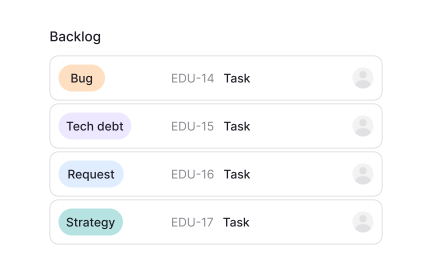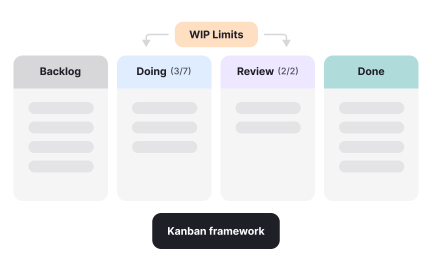Scrumban
Scrumban combines Scrum’s structure with Kanban’s flexibility, helping teams manage ongoing work while staying responsive to changing needs.
What is Scrumban?
Your team struggles because Scrum feels too rigid with fixed sprints that interrupt flow, while pure Kanban lacks the structure needed for planning and coordination, leaving you torn between methodologies that each solve half your problems while creating new ones.
Most teams force themselves into pure Scrum or Kanban without realizing they can combine the best of both, missing the hybrid approach of Scrumban that provides Scrum's planning structure with Kanban's continuous flow and work-in-progress limits.
Scrumban is a hybrid agile methodology that combines Scrum's structured planning and review ceremonies with Kanban's visual workflow management and continuous delivery, creating flexible framework that adapts to team needs rather than forcing teams into rigid processes.
Teams using Scrumban achieve 55% better flow efficiency, reduce context switching by 40%, and report significantly higher satisfaction because the methodology adapts to their work rather than forcing work to fit methodology constraints.
Think about how maintenance teams need both planned work and urgent response capability, or how platform teams balance feature development with operational demands that don't fit neatly into two-week boxes.
Why Scrumban Matters for Modern Teams
Your development process creates friction because pure Scrum forces artificial sprint boundaries on work that flows continuously, while pure Kanban lacks coordination mechanisms for teams needing alignment and predictable delivery commitments.
The cost of methodology mismatch compounds through every forced sprint ending or coordination failure. You interrupt developer flow for arbitrary ceremonies, struggle with unplanned work in Scrum, lack planning in Kanban, and frustrate teams who need flexibility with structure.
What effective Scrumban delivers:
Better work flow and reduced waste because teams pull work when ready rather than batching into sprints, while maintaining planning ceremonies that provide direction and coordination.
When teams implement Scrumban properly, work flows smoothly rather than accumulating at sprint boundaries or lacking direction in pure flow systems.
Enhanced flexibility with structure through optional Scrum ceremonies combined with Kanban's visual management and WIP limits rather than all-or-nothing methodology adoption.
Improved handling of multiple work types because Scrumban accommodates both planned features and operational demands rather than forcing everything into sprint commitments.
Stronger team autonomy and satisfaction as teams customize their process rather than following prescribed methodology that doesn't fit their context.
Reduced overhead with maintained alignment through lighter-weight ceremonies that provide value rather than ritual compliance with full Scrum framework.
Advanced Scrumban Approaches
Once you've mastered basic Scrumban, implement sophisticated flow optimization and scaling approaches.
Multi-Team Scrumban Coordination: Synchronize planning across teams while maintaining independent flow rather than forcing common sprints, balancing autonomy with alignment.
Class of Service Implementation: Define different work types with separate policies rather than treating everything equally, optimizing flow for each category.
Probabilistic Forecasting: Use flow metrics for predictions rather than story points, providing reliable forecasts based on actual cycle time data.
Evolutionary Scrumban Metrics: Track methodology effectiveness rather than just delivery metrics, ensuring continuous process improvement based on outcomes.
Step 1: Start with Current State Visualization (Week 1)
Map existing workflow on Kanban board regardless of current methodology rather than designing ideal state, understanding actual work patterns before changing them.
This creates Scrumban foundation based on reality rather than theoretical process that ignores how work actually happens in your organization.
Step 2: Identify Which Ceremonies Add Value (Week 1-2)
Evaluate each Scrum ceremony for your context rather than keeping all or none, selecting planning, reviews, and retrospectives that genuinely improve outcomes.
Focus ceremony selection on value delivery rather than methodology purity, keeping what helps while eliminating what frustrates without benefit.
Step 3: Implement Work-in-Progress Limits (Week 2-3)
Add WIP limits to prevent overload while maintaining flow rather than unlimited parallel work, finding balance between utilization and sustainable pace.
Balance WIP limits with team capacity to ensure flow without idle time, adjusting based on measured cycle time rather than arbitrary numbers.
Step 4: Design Trigger-Based Planning (Week 3-4)
Replace fixed sprint planning with trigger-based replenishment rather than artificial batch timing, planning when backlog drops below threshold rather than calendar schedule.
Step 5: Evolve Based on Metrics and Feedback (Month 2+)
Measure flow metrics and team satisfaction rather than velocity, optimizing for sustainable delivery rather than maximizing output without regard for outcomes.
This ensures Scrumban serves team needs rather than becoming another rigid framework that constrains rather than enables effective delivery.
If Scrumban doesn't improve flow, examine whether you're truly hybrid rather than doing Scrum with Kanban board or Kanban with meetings.
The Problem: Teams that claim Scrumban but really just do ad-hoc process without discipline from either methodology, creating chaos labeled as flexibility.
The Fix: Define clear Scrumban implementation rather than abandoning all structure, documenting which elements from each methodology you're adopting and why.
The Problem: Stakeholders uncomfortable with variable planning cycles who demand return to fixed sprints for predictability illusion.
The Fix: Demonstrate predictability through flow metrics rather than sprint commitments, showing that continuous delivery provides better forecasting than batch planning.
The Problem: Teams that cherry-pick easiest parts of both methodologies, avoiding challenging practices like WIP limits or retrospectives that drive improvement.
The Fix: Commit to valuable practices even if difficult rather than comfortable process, ensuring Scrumban includes elements that drive improvement not just convenience.
Create Scrumban approaches that optimize flow while maintaining coordination rather than chaos masquerading as flexibility.
Recommended resources
Courses

Accessibility Foundations

Wireframing





